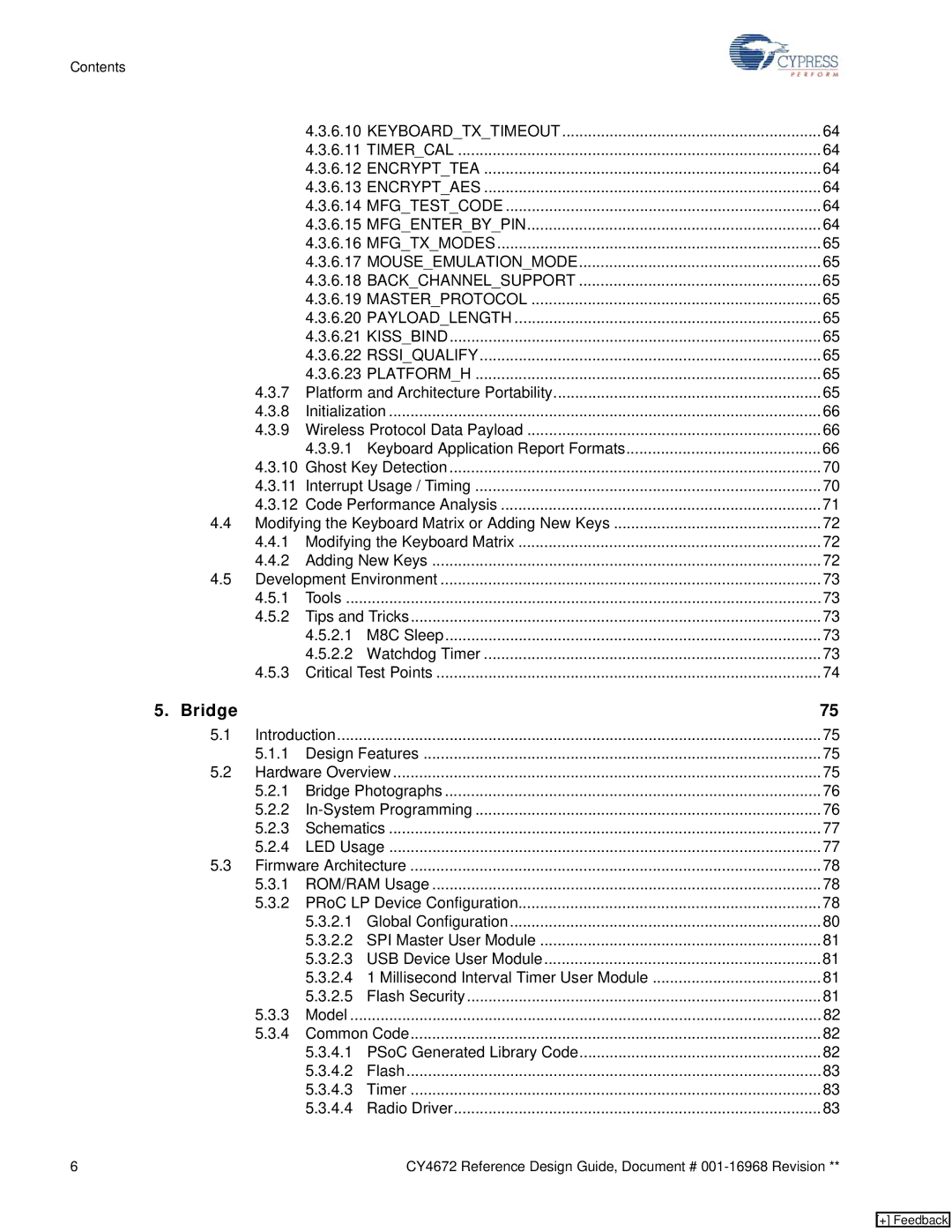Contents
| 4.3.6.10 | KEYBOARD_TX_TIMEOUT | 64 |
| 4.3.6.11 | TIMER_CAL | 64 |
| 4.3.6.12 | ENCRYPT_TEA | 64 |
| 4.3.6.13 | ENCRYPT_AES | 64 |
| 4.3.6.14 | MFG_TEST_CODE | 64 |
| 4.3.6.15 | MFG_ENTER_BY_PIN | 64 |
| 4.3.6.16 | MFG_TX_MODES | 65 |
| 4.3.6.17 | MOUSE_EMULATION_MODE | 65 |
| 4.3.6.18 | BACK_CHANNEL_SUPPORT | 65 |
| 4.3.6.19 | MASTER_PROTOCOL | 65 |
| 4.3.6.20 | PAYLOAD_LENGTH | 65 |
| 4.3.6.21 | KISS_BIND | 65 |
| 4.3.6.22 | RSSI_QUALIFY | 65 |
| 4.3.6.23 PLATFORM_H | 65 | |
4.3.7 | Platform and Architecture Portability | 65 | |
4.3.8 | Initialization | 66 | |
4.3.9 | Wireless Protocol Data Payload | 66 | |
| 4.3.9.1 | Keyboard Application Report Formats | 66 |
4.3.10 Ghost Key Detection | 70 | ||
4.3.11 | Interrupt Usage / Timing | 70 | |
4.3.12 Code Performance Analysis | 71 | ||
4.4 Modifying the Keyboard Matrix or Adding New Keys | 72 | ||
4.4.1 | Modifying the Keyboard Matrix | 72 | |
4.4.2 | Adding New Keys | 72 | |
4.5 Development Environment | 73 | ||
4.5.1 | Tools | 73 | |
4.5.2 | Tips and Tricks | 73 | |
| 4.5.2.1 | M8C Sleep | 73 |
| 4.5.2.2 | Watchdog Timer | 73 |
4.5.3 | Critical Test Points | 74 | |
5. Bridge |
|
|
| 75 |
5.1 | Introduction | 75 | ||
| 5.1.1 | Design Features | 75 | |
5.2 | Hardware Overview | 75 | ||
| 5.2.1 | Bridge Photographs | 76 | |
| 5.2.2 | 76 | ||
| 5.2.3 | Schematics | 77 | |
| 5.2.4 | LED Usage | 77 | |
5.3 | Firmware Architecture | 78 | ||
| 5.3.1 | ROM/RAM Usage | 78 | |
| 5.3.2 PRoC LP Device Configuration | 78 | ||
|
| 5.3.2.1 | Global Configuration | 80 |
|
| 5.3.2.2 SPI Master User Module | 81 | |
|
| 5.3.2.3 USB Device User Module | 81 | |
|
| 5.3.2.4 1 Millisecond Interval Timer User Module | 81 | |
|
| 5.3.2.5 | Flash Security | 81 |
| 5.3.3 | Model | 82 | |
| 5.3.4 | Common Code | 82 | |
|
| 5.3.4.1 PSoC Generated Library Code | 82 | |
|
| 5.3.4.2 | Flash | 83 |
|
| 5.3.4.3 | Timer | 83 |
|
| 5.3.4.4 | Radio Driver | 83 |
6 |
|
| CY4672 Reference Design Guide, Document # | |
[+] Feedback
